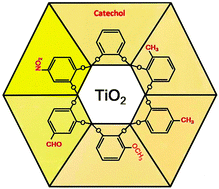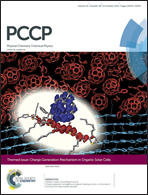The effect of substituents on the surface modification of anatase nanoparticles with catecholate-type ligands: a combined DFT and experimental study†
Abstract
The surface modification of nanocrystalline TiO2 particles (45 Å) with catecholate-type ligands having different electron donating/electron withdrawing substituent groups, specifically 3-methylcatechol, 4-methylcatechol, 3-methoxycatechol, 3,4-dihydroxybenzaldehyde and 4-nitrocatechol, was found to alter the optical properties of nanoparticles in a similar way to catechol. The formation of the inner-sphere charge-transfer (CT) complexes results in a red shift of the semiconductor absorption compared to unmodified nanocrystallites and a reduction of the effective band gap, being slightly less pronounced in the case of electron withdrawing substituents. The investigated ligands have the optimal geometry for binding to surface Ti atoms, resulting in ring coordination complexes of the catecholate type (binuclear bidentate binding–bridging) thus restoring six-coordinated octahedral geometry of surface Ti atoms. From the absorption measurements (Benesi–Hildebrand plot), the stability constants in methanol/water = 90/10 solutions at pH 2 in the order of 103 M−1 have been determined. The binding structures were investigated by using FTIR spectroscopy. Thermal stability of CT-complexes was investigated by using TG/DSC/MS analysis. Quantum chemical calculations on model systems using density functional theory (DFT) were performed to obtain the vibrational frequencies of charge transfer complexes, and the calculated values were compared with the experimental data.


 Please wait while we load your content...
Please wait while we load your content...